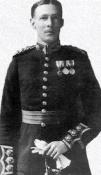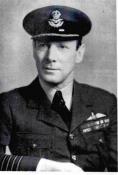
War Memorial
| Lieutenant Harry Melville Arbuthnot DAY AM | |
|
Royal Marine Light Infantry Date of birth: 3rd August 1898 Date of death: 2nd December 1977 Died aged 79 Buried at Ta' Braxia Cemetery, Malta |

|
| Harry Melville Arbuthnot "Wings" Day was born at Kuching, Sarawak in Borneo on the 3rd of August 1898 the son of Harry Robert Arbuthnot Day and Annie Day of Sarawak. He was educated at Hazelwood School until July 1912 where he was a member of the Football XI in 1909, 1910 and 1911. He was a member of the Cricket XI in 1911 and 1912. The school magazine wrote the following of his 1909 football season: - "(Inside left) - Has a bad trick of lying down without due cause, and so upsetting all combination; with a little left foot practice and greater determination, might become a marksman." Of his 1910 football season they wrote: - "(Left half) A plucky and hard working half; not always as careful as he should be in his transfer of the ball, but bright with promise for the future." They wrote of his 1911 football season: - "(Centre half) - The incarnation of pluck, opposing height and weight having for him no terrors; second only to his captain in usefulness to the team; heads splendidly; what he requires to make an ideal half is to improve his shooting and his nursing of his forwards, varying his passes with a judicious dribble." The magazine wrote the following of his 1911 cricket season: - "A disappointment. Dropped many catches, made no runs, and showed small promise as a bowler. In spite of this we believe he will be useful next year." Of his 1912 cricket season they wrote: - "Disappointing in all departments of the game; at his best in the field, his nerves seldom permitting distinctions with bat or ball." On leaving the school the magazine wrote of him: - "... migrates to Haileybury. His health, which was not robust, has improved in the most marvellous fashion, and we trust that this advance may be maintained. Disappointing as a cricketer, he was on the football field the incarnation of pluck, and was not without merit as a hockey player. Has a distinct talent for drawing, which he is not likely to neglect. We wish him luck." He went on to Haileybury School, where he was in Colvin House from December 1912 to July 1916 and was a member of the Officer Training Corps. On leaving school he was commissioned as a probationary 2nd Lieutenant in the Royal Marine Light Infantry on the 1st of September 1916 and was promoted to Lieutenant on the 26th of September 1917. He was a member of the Royal Marine detachment on board the battleship HMS Britannia on the morning of the 9th of November 1918 off Cape Trafalgar when, at 6.45am, she was hit amidships by the third of three torpedoes fired by the U Boat U50, under the command of Oberleutnant zur See Heinrich Kukat. She sank three hours later with the loss of forty of her crew. Harry Day was one of the survivors but not before he rescued two of his shipmates. For his action that day he was awarded the Albert Medal for gallantry in saving life at sea and the citation read as follows:- “On November the 9th 1918 HMS "Britannia" was torpedoed by an enemy submarine. The explosion of the torpedo was followed by another and more violent explosion of ammunition, and fires were started, resulting in the spread of smoke and fumes. Shortly after the explosion Lieutenant Day went down to the ward room to search for wounded. He heard groaning forward of the ward room, but found that the heavy wooden door leading forward had jammed and was immovable. He then burst open the trap hatch to the ward room pantry and climbed through it. He discovered Engineer Lieutenant Stanley F. Ward RN and a ward room steward alive and conscious, but unable to move. Fearing that he would hurt them if he endeavoured to drag them through the trap hatch single handed, he climbed back into the ward room aft and up on to the quarter deck, and procured two or three stokers, with whom he eventually carried the dying officer and man on deck and to the forecastle. During his first visit to the ward room, Lieutenant Day was alone, in the dark, the ship with a list and fire close to the 12in magazine. While carrying out this rescue work he inspected all scuttles and deadlights in the ward room (and cabins before it) and ascertained that all were properly closed before leaving. The cordite fumes were very strong, and his life was in danger throughout. His courage and resource were beyond praise.” HMS Britannia was the last British warship lost during the Great War. In 1971 all Albert Medal holders were entitled to exchange their medals for a George Cross which Harry Day did. On the 16th of June 1924 he was seconded to the Fleet Air Arm as a Marine Pilot and was based at Leuchars in Fife before being transferred to the Mediterranean later that year. In 1926 he was transferred to the China Station with HMS “Hermes”, based at Hong Kong. He was married to Doreen (nee Holgate) on the 28th of November 1926 at Hong Kong on board HMS “Tamar” and they had a daughter, born on the 3rd of June 1927. They lived at "Torwood, Whyteleafe in Surrey and later at "The Thatched Cottage", Wannock, Polegate in Sussex. In 1927 he was promoted to Captain and transferred to the Royal Air Force with a permanent commission on the 21st of June 1930 with the rank of Flight Lieutenant and with seniority from the 1st of July 1928. On the 21st of March 1931 he obtained his Aero Club Certificate (number 9756). He became a noted stunt flyer, leading the Royal Air Force display team with future flying ace Douglas Bader as one of his wingmen. He was posted to the Middle East, serving at Abu Sueir and at Khartoum and remaining there for five years. On his return to England he was placed in command of an advanced flying training school at Little Rissington. He was promoted to Squadron Leader in 1938 and was Commanding Officer of the air station at Kenley. By August 1939 he was an Acting Group Captain and was given command of 57 Squadron. On the 12th of October 1939 Harry Day and his crew flew with other aircraft from B Flight, 57 Squadron from Roye to Metz for a mission they were to undertake the following day. On the 13th of October 1939 they took off at 1pm from Metz in Bristol Blenheim Mk1 L1138 DX for a reconnaissance mission over Hamm. Their aircraft was attacked by three Messerschmitt 109's but the victory was credited to Unteroffizier Stefan "Stefi" Lutjens of 11/JG53. Day described the events in a postcard to his wife: - "As I expect you have heard, I was shot down by three German fighters about 30 miles the wrong side of the line. They hit my petrol tank which burst into flames. My back gunner was killed. My Observer was killed getting out of the machine, as his parachute had not been ripped when he was found later. I got away by parachute, but got burned around the head...." An investigation into the incident was undertaken in 1947 when a report was written: - "Investigations were carried out on 27.2.1947 and the following information obtained: - Burgomeister of Langweiller stated that on 13.10.39 at approx 1330hrs. a twin engined bomber which was on fire, exploded in mid air over the village. Just before the explosion he saw one airman bale out. The wreckage of the plane was spread over a large area but the main part was in the wood near the village. He went to the scene of the crash and saw one severely burned body, a few minutes later another body, also severely burned was found 200 metres away. A German doctor identified the bodies and they were removed for burial to Kaiserslautern. The member of the crew who had baled out was caught in a tree and taken into custody first by the police then handed over to the Wehrmacht. he was slightly wounded about the head. The Buromeister's son confirmed the above and added that the aircraft was a Bristol Blenheim." His two fellow crew members who were killed were Acting Sergeant Eric Bernard Hillier (Observer) and Aircraftman 2nd Class Frederick George Moller (Wireless Operator/Air Gunner). Harry Day was wounded, captured and held as a prisoner of war as POW number 37. His wife received the following telegram dated the 15th of October 1939: - "Regret to inform you that our husband, Wing Commander Harry Melville Arbuthnot Day AM is reported as missing as the result of air operations on 13/10/39 - Letter follows." He wrote a letter to his wife dated the 29th of October 1939 from Oflag IX-A at Spangenburg in north eastern Germany which described his confinement: - "Still no letter from you..... The dormitory I live in lies at the end of a passage on the ground floor. It is about 18 paces square and 12 feet high. The floor is a grubby looking parquet. The walls are painted green to about 2/3 of the way up and then white. The ceiling is ordinary white plaster with three hanging electric lights in white globes. There are two large windows and one medium sized one with sills about waist high. In the outer two recesses made for the windows are radiators. In between the two large windows is a recess with an arrow slit. This has one of the two wardrobes in front of it. The windows face south and overlooks the moat and valley with the village and railway at the bottom. The view consists of hills and woods and is rather fine. The beds are ranged tound the three main walls with the feet of the beds pointing to the centre. UIn the clear space in the centre is a bare wooden table with kitchen chairs. On the walls are nails to hang out few possessions. The beds are grey painted iron except mine which is white. We sleep in the following order starting from the west window and going clockwise - myself, Casey, Tillesley, Maclachan. The north wall is the door, our second wardrobe, Nichols, Thurston. The west wall, Murray, Edwards, Thompson, Coste, Baugham, Griffiths. The rooms are nice and warm which is as well as we get only two blankets. I and some others are lucky who have flying kit to use. Sheets are supplied. The beds are sprung but the mattresses are hard. It is in this room our life is centred but we can visit the other dormitories (French officers) and there is a small reading room - no books but some have been promised." Letter of the 2nd of November 1939: - "Snow fell earlier in the week - piling up in one night and covering everything. Now it has all gone. Good skating could probably be got, even skiing - Not that these sports are likely to affect us, but I think some football is going to be arranged. Everyone has been issued with a great coat yesterday - result is we look like Polish prisoners - greatcoats being captured from them. No more news I am sending a list of things I want by P.C. It will probably get through quicker than this. By the way I have been talking to Murray who has received a letter written only a fortnight ago. I therefore forward his experience for you information. The letter has been enclosed in two envelopes. The inner envelope is addressed to me as above, The outer is addressed to me C/O Agent de Prisonniers de Geurre, Palias du Conseil general, Geneva, Switzerland. Another suggestion, the war at present appears to be at a standstill, what about getting someone to start a press campaign for an exchange of prisoners as an Xmas gesture for both sides." The German magazine "Der Adler" carried the following in its issue of the 16th of April 1940: - "The British Wing Commander Day is a great lover of cats. he did not have to miss his four legged friends even as a prisoner." As a prisoner of war he served as Senior British Officer in a number of different camps and a noted escaper. In May 1941, while senior British officer at Stalag Luft I near Frankfurt-am-Main, he and seventeen others tunneled out of the camp. For five days he was at liberty before being recaptured. He organised a number of other escapes and became regarded as dangerous so was moved to Poland in March 1942. He was moved to Stalag Luft III at Sagan, where he made a second escape attempt using a forged interpreter's pass. While in solitary confinement after that escape he tried a third escape but was again recaptured. In October 1942 he was sent to Oflag XXIB at Schubin but returned later to Sagan where in March 1943 he and 35 others tunnelled out. This time Day headed east through Poland, hoping to get on a ship to Sweden. He was recaptured and sent back to Sagan. On the night of the 23rd/24th of March 1944 Harry Day and 76 others took part in what became known as “The Great Escape”, he once again made his way to Stettin and once again was arrested. Three of the escapers managed to get home, while 50 were murdered by the Gestapo and 23 were returned to camps. After interrogation by the Gestapo he was sent to Sachsenhausen concentration camp, from where he managed another escape before being recaptured by the SD civilian defence force. He was again returned to Sachsenhausen where he was chained to the floor and interrogated for six weeks in manacles. After another visit to Gestapo headquarters he was sent to the concentration camp at Flossenburg, where he remained until April 1945 when he and some fellow prisoners were taken on a bus to Italy, via the Brenner Pass, to be executed in an air raid shelter by using hand grenades. The bus ran out of petrol and Day managed to confuse and frighten the SS guards and succeeded in contacting Italian partisans thereby bringing about a rescue by American units which were in the area. At the end of 1945, for his services while a prisoner, he was awarded the Distinguished Service Order on the 28th of December 1945. The citation reads:- "Wing Commander Day was shot down on 13th October 1939, captured and imprisoned in various camps, where for two and one-half years he was the Senior British Officer. In May 1941, while at Stalag Luft this officer, with 17 others, made an escape by tunneling. On the fifth day of liberty he was discovered by two woodsmen who captured him. For this attempted escape he was sentenced to ten days imprisonment. Soon after his arrival at Sagan in march 1942 he made another attempt to escape by using a forged interpreter's pass but the guard became suspicious and arrested him. Wing Commander day was sentenced to 14 days imprisonment during which time a made a further unsuccessful attempt. In March 1943 he participated in an escape with 35 others by means of a tunnel and although help up in the tunnel for three hours during which time he helped to extricate a fellow escaper who had become jammed, he eventually got away from the camp and gained the Posen-Warsaw railway line. The following morning, thinking he was in Poland proper, he approached a boy for food but the boy was a Hitler Youth and called the Landswache who arrested Wing Commander Day and his companion. On the night of 25th-26th March, 1944, this officer and about 80 others made their escape through a tunnel 20 feet deep and 400 feet long. Day and a Polish officer made their way to Berlin by train and stayed the night with a German family who thought he was being escorted by his companion who was dressed as a German officer. The following day they entrained for Stettin, arriving without incident. They were seeking a place to spend the night when some apparently French prisoners of war agreed to give them shelter. The next morning the Gestapo arrived and they were put in jail. Wing Commander Day and the Polish officer were taken to Berlin for interrogation by a Gestapo general, who threatened to have them shot. Day was later taken to Sachsenhausen concentration camp where in September 1944, he made another attempt to escape and again reached Berlin. Here he tried to make certain contacts at an address he had been given but the place had been bombed. He tried to hide in the wreckage but was seen and recaptured. He was taken to the Gestapo Headquarters for interrogation and eventually moved to the Gestapo Concentration Camp at Floosenburg, where he remained until April 1945. On 15th April, 1945, Wing Commander Day was moved to Villabassa where with the aid of an Austrian member of an underground movement he reached Allied hands at Borgo." He was made an Officer of the Order of the British Empire (Military Division). In 1968 Sidney Smith published a book of his story entitled “Wings Day”. He died at the Blue Sisters Hospital in Malta. |
|
 | |
| Went on to Haileybury School |
Back